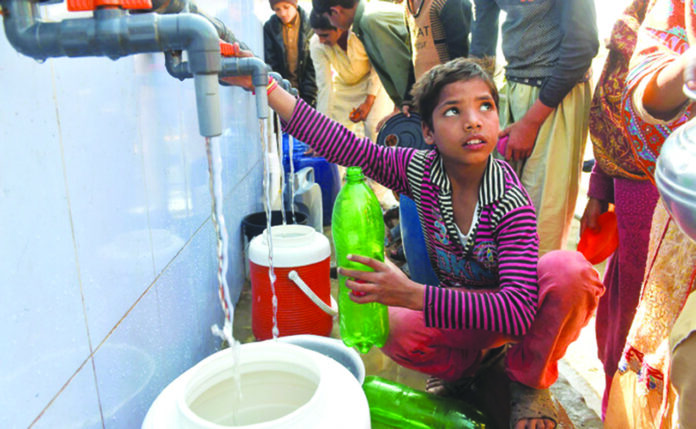According to a UNDP water report, Pakistan may reach absolute water scarcity level with water availability of less than 500 cubic meters per person by 2025. At present the per capita availability of water in Pakistan is 930 cubic meters per annum. It must be remembered that back in June 2015 NASA had found that the Indus River Basin had acquired the status of the second most water stressed basin. Now Pakistan is water scarce, below the level of a water stressed country.
The United Nations Development Program and Pakistan Council of Research in Water Resources (PCRWR) have warned of an “absolute water scarcity and a drought by 2025 if no proper solution is sought”
In 2022 a study by University of York revealed that the Ravi is the most polluted river of the whole world. WWF (The Worldwide Fund for Nature) reported that 2700 industries throw their untreated discharge in the Ravi and have transformed it into a drain. Lahore has already been declared to be the second most polluted city of the world. Climate change hazards are also there as the glaciers are melting at a fast pace and pose a serious threat to climate.
According to the Indus Water Treaty signed in 1960, control of the Ravi was given to India along with the Beas and Sutlej of the Indus Basin. In February 2024 the construction of the Shahpur Kandi barrage was completed in Pathankot district area by India and it stopped the water flow to Pakistan depriving it of its share of 1,150 cusecs water adding to water terrorism by India. Here it is also important to note that India had constructed 5,334 large dams by 2019. Its position is now third all over the globe after the USA and China, in respect of constructing large dams.
The water experts are of the view that an estimated amount of 30 Million Acre Feet water is wasted away which passes through Pakistan every year. Water worth $29 billion every year goes unused and wastes away in the Arabian Sea which invites need for better water management by Pakistan for using it to its advantage strategically.
The ground water level of Pakistan is declining rapidly. About 50 to 55 MAF water is pumped out of the ground every year in Pakistan which is causing depletion of water tables, as only 40 to 45 MAF is recharged. The problems leading to water scarcity include an enormous increase in population, seepage of water, water theft and insufficient construction of water reservoirs. Climate change and heat waves are adding to the problem. Insecticides used for crops make the natural reserves of water contaminated and also spoil the water quality for drinking purposes, leading to increasing challenges of urban water management and poor drinking water quality.
In Singapore 40 percent of water needs are met by recycling wastewater. Likewise, we, too, may recycle and reuse wastewater by replicating this model. Small dams in provinces are more important. Conservators to monitor the glaciers and to link them with the rivers should be made. Efforts are required to conserve water, expeditiously manage it and take steps to ensure good governance of water.
To fight this problem, sustainable solutions through long term plans are required. Through proper planning wastage of water in the irrigation system can be overcome. According to the Economic Survey of Pakistan 2023-24, agriculture contributes 24 percent of Pakistan’s GDP. Attention should be given to aquifer management as in many areas crops are rain fed. One solution may be rainwater harvesting. Pakistan gets 145 Million Acre Feet every year from rain and glacial melt, but we use only 14 MAF and the rest is wasted away. Making more of the small rain fed dams to serve for crops can be a good solution. This will recharge the groundwater levels. Technology should be used to minimize the water seepage from the pipes. An aquifer authority can be made to monitor the water level and work needs to be done on spatial modeling of groundwater aquifer depletion or recharge.
Dam equivalents can be helpful in dealing with the problem of water loss. In 2018 the first national water policy of Pakistan (NWPP) was formulated in Pakistan and at present reforms are needed in this policy to address the issue of water security.
The behavioural change may be brought for right use of water through publicity campaigns at domestic level. The public, especially women who are larger consumers of water in households, should be made aware of water conservancy methods. This campaign programme can be launched in schools as well. Through mass media people can be made aware to adopt measures for conservation of water like fixing leaks in the houses, installing water efficient shower heads, tracking water meters to limit water usage, planting drought tolerant plants, taking shorter showers, and so on. People should also be asked to install automatic float valves in their water tanks to avoid overflowing of water. At government level the proper fixing of the taps in water filtration plants is required on a regular basis as most often the taps are leaking, and precious filtered water goes on wasting.
Other solutions may include the latest marketing system with the help of information technology asking farmers to sow the crops which give more profit. The farmers’ knowledge about cost and expenditure generally is very low. They should be trained how to improve the use of water and minimize the expenditure which can help improve their production. In order to overcome water scarcity different techniques like drip irrigation in agriculture can be taught to the farmers. At the government level, improving the efficiency of the canal system can yield good results. Experts skilled in hydro informatics and hydro geology can be asked to develop an Integrated Data Information System (IDIS) for River Basin management.
In Singapore 40 percent of water needs are met by recycling wastewater. Likewise, we, too, may recycle and reuse wastewater by replicating this model. Small dams in provinces are more important. Conservators to monitor the glaciers and to link them with the rivers should be made. Efforts are required to conserve water, expeditiously manage it and take steps to ensure good governance of water.























